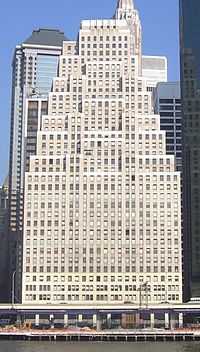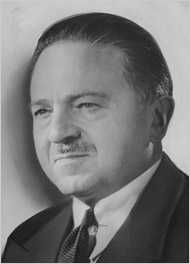Ely Jacques Kahn
| Ely Jacques Kahn | |
|---|---|
|
Historical photo of Ely Jacques Kahn | |
| Born |
1884 New York City |
| Died |
1972 New York City |
| Nationality | American |
| Alma mater | Columbia University |
| Occupation | Architect |
| Religion | Judaism |
| Spouse(s) | Elsie P. Kahn |
| Children |
Joan Kahn Ely Jacques Kahn, Jr. Olivia Kahn |
Ely Jacques Kahn (1884–1972) was an American commercial architect who designed numerous skyscrapers in New York City in the twentieth century.[1] In addition to buildings intended for commercial use, Kahn's designs ranged throughout the possibilities of architectural programs, including facilities for the film industry. Many of his numerous buildings under the 1916 Zoning Resolution feature architectural setbacks[2] to keep the building profitably close to its permitted "envelope" and have been likened to the stepped form of the Tower of Babel:[3] a notable example is his 1400 Broadway (1931).
Life and career
Kahn was born in New York, the only son of a prosperous Austrian and French Jewish family. His father brought design wares from Europe to sell in New York, perhaps providing his earliest introduction to design. Ely Jacques Kahn traveled to Europe where he was aware of the work of architect Josef Hoffman.[4] He attended Columbia University and later was a professor at Cornell University. Kahn was the father of noted New Yorker magazine writer Ely Jacques Kahn, Jr., and great-grandfather of Ely Jacques Kahn IV, former Director of Cybersecurity Policy at the White House.
Kahn's partnership with Albert Buchman lasted from 1917 until 1930. In this period his work alternated Beaux-Arts with cubism, modernism, and art deco, of which examples are 2 Park Avenue (1927), using architectural terracotta in jazzy facets and primary colors, the Film Center Building in Hell's Kitchen (1928–29) and the Squibb Building (1930), which Kahn considered among his best work.[5] In what has become an iconic photograph, Kahn masqueraded as his own Squibb Building with other architects dressed as buildings for the Beaux Arts Ball of 1931.[6][7] The building moved decisively away from the decorative modernity of the Art Deco 20s: Lewis Mumford praised it in 1931 as “a great relief after the fireworks, the Coney Island barking, the theatrical geegaws that have been masquerading as le style moderne around Manhattan during the last few years.”[5]
Kahn, who had taken full control of the practice of Kahn & Buchman in 1930, as Ely Jacques Kahn Architects, produced some commercial skyscrapers that combined traditional massing with a skin pared of all details, such as the 42-storey Continental Building (1931) at Broadway and West 41st Street.[8]
In 1940, he formed a partnership with Robert Allan Jacobs, the son of architect Harry Allan Jacobs. An exemplary work of this period is the Universal Pictures Building of 1947 which was used by Reyner Banham to illustrate air conditioning.[9] Another is 100 Park Avenue, and the firm later collaborated with Ludwig Mies van der Rohe and Philip Johnson on the Seagram Building. In 1944, Kahn and Jacobs rendered a prosaic program, the Municipal Asphalt Plant as a free-standing sculptural essay in concrete covering four parabolic steel arches, familiar to any driver on the FDR Drive (at 90th-91st Streets).[10] For the New York Stock Exchange, Kahn & Jacobs created additional facilities in 1956 designed with their characteristic zig-zag of setbacks in the upper stories.[11]
Kahn's work just after World War II had direct relevance to Judaism. In 1946, he began a renovation of Central Synagogue.[12] In 1947, he wrote on the subject of design principles for synagogues in an article entitled, "Creating a Modern Synagogue Style: No More Copying."[13] In 1948, with sculptor Jo Davidson, Kahn made the first public plan for a Holocaust memorial in the United States.[14] The chosen site for this project in Riverside Park later bore other projects for memorials by Percival Goodman, and Erich Mendelsohn.
Although Kahn retired some years earlier, the firm of Kahn & Jacobs lasted until 1973, the year after Kahn's death.[15]
Kahn's extensive architectural drawings and papers, including materials from the firms Buchman & Kahn and Kahn & Jacobs, are held in the Department of Drawings & Archives at the Avery Architectural and Fine Arts Library at Columbia University.
Kahn and Ayn Rand

As part of her research for her novel The Fountainhead, Ayn Rand spent a half year in 1937 as an unsalaried assistant to Kahn in his offices in his 2 Park Avenue building, where he mentored her on the profession of architecture. She is quoted by the editor of her posthumously published journal notes as later saying about Kahn: "As a type, he was Guy Francon. He was so much the socially acceptable architect. He was abler than Francon, and he was modern—within careful limits. But his career was strictly dominated by Francon methods. And he had that manner—very elegant and charming."[16]
As argued by Frank Heynick, the summary quote by Rand does not do justice to Kahn's work, nor, based on Heynick's study of Rand's posthumously published journal notes, correspondence and other references, to her own respect for Kahn and his buildings.[16] The fictional Francon had achieved fame in his early forties with an ornate Greco-Roman skyscraper, but had long ceased to do any designing for the large firm he co-owned, instead concentrating on socializing with wealthy clients and potential clients, for whom his chief designer and staff would produce buildings in whatever historicist style they desired. (This was quite the opposite of the uncompromising individualism and innovative genius of the novel's hero Howard Roark, who is based in large measure on the real-life Frank Lloyd Wright.)
By contrast with Francon, Ely Jacques Kahn, although he socialized as needed with clients, was throughout his long career personally involved in designing all the buildings produced by the firm he headed, and those designs often attested to his integrity and innovation in the forms and motifs of his skyscrapers. Although trained—like the fictional Francon—at the École des Beaux-Arts in Paris, Kahn rejected historicist styles in skyscraper design. His adaptations within New York's legally-mandated set-back regulations included high-rises with resemblances to New World temples of the Mayas, and he variously incorporated features such as thrusting dormers and aerodynamic effects. As for ornamentation, Kahn, who earlier had been inspired by the abstract geometric forms of Moorish and Persian architecture, was, from the mid-twenties onward, highly innovative in adapting the new Art Deco style with polychrome cubist or zigzag motifs reflecting the Jazz Age.[16]
When The Fountainhead was nearing publication, Rand suggested to Kahn that she specifically acknowledge him in an introductory statement. But Kahn modestly—perhaps wary that the novel's theme might prove too controversial—proposed instead that she write a more general acknowledgement to, as published, "the great profession of architecture and its heroes" and to "the architects who gave me their generous assistance."[16]
References
Notes
- ↑ Stern, Jewel and Stuart, John A. Ely Jacques Kahn, Architect: Beaux-arts to Modernism in New York, Norton, 2006, ISBN 0-393-73114-6
- ↑ Ferriss, Hugh. The Metropolis of Tomorrow, Princeton Architectural Press, 1986, p. 166 ISBN 0-910413-11-8
- ↑ Bedoire, Frederic. The Jewish Contribution to Modern Architecture: 1830-1930, KTAV Publishing House, 2004, pp. 436-438, ISBN 0-88125-808-3
- ↑ Stern, Robert A.; Gilmartin, Gregory and Mellins. New York 1930, Rizzoli, 1995, pp. 551-558, ISBN 0-8478-1838-1
- ↑ 5.0 5.1 "745 Fifth Avenue" on The City Review website
- ↑ Koolhaas, Rem, Delirious New York: A Retroactive Manifesto for Manhattan, Monacelli Press, 1994, p. 128, ISBN 1-885254-00-8
- ↑ Goldberger, Paul. The Skyscraper, Knopf, 1981, p. 79, ISBN 0-394-50595-6
- ↑ "The Continental Building" on Emporis
- ↑ Banham, Reyner. Architecture of the Well-Tempered Environment, University of Chicago Press, 1984, p. 223 ISBN 0-226-03698-7
- ↑ "This bold work of 'industrial architecture' has not been matched in New York for bald functional and esthetic logic." AIA Guide to New York City (1st ed.) New York: Macmillan, 1968. p.181
- ↑ "New York Stock Exchange Annex" on Emporis
- ↑ Shulman, Ken. "Restoring the Soul" Metropolis (October 2000)
- ↑ Kahn, Ely Jacques. "Creating a Modern Synagogue Style: No More Copying", Commentary (June 1947)
- ↑ Young, James. The Texture of Memory: Holocaust Memorials and Meaning, Yale University Press, 1994, p. 290, ISBN 0-300-05991-4
- ↑ Stern 2006, p. 56
- ↑ 16.0 16.1 16.2 16.3 Heynick, Frank. "The Guy Francon Who Wasn't" on The Atlasphere website (May 6, 2010)
External links
| Wikimedia Commons has media related to Ely Jacques Kahn. |
- Ely Jacques Kahn (1884-1972) and Kahn & Jacobs, Avery Architectural and Fine Arts Library, Columbia University
- Hohenems Genealogy Database
|
